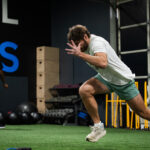Speed Training for Soccer: How to Increase First-Step Quickness
In soccer, a quick first step can be the difference between winning and losing a play. Whether you’re closing in on an opponent or exploding into a sprint, your first movement determines your speed and success. That’s why speed training for soccer should include drills that focus on first-step quickness.
This article will walk you through why the first step matters, how to train it, and the best exercises to improve it.
Why First-Step Quickness Matters in Soccer
Soccer is a game of constant movement and reaction. First-step quickness helps players:
-
Accelerate past defenders to create scoring chances
-
Close down space defensively in 1v1 situations
-
React to passes, rebounds, and deflections faster
-
Recover quickly after a misstep or turnover
According to the NSCA, acceleration and agility training improve an athlete’s ability to change speed and direction, which is crucial in soccer.
What Affects First-Step Quickness?
Several physical and technical elements determine how explosive your first step is:
-
Leg strength: Strong glutes, hamstrings, and quads power the initial push
-
Balance and posture: A low, stable stance enables a clean start
-
Neuromuscular reaction time: How fast your brain sends signals to your muscles
-
Foot placement: Correct angles create efficient drive-off power
-
Arm swing mechanics: Help initiate full-body movement
By training each of these, you can boost your first-step quickness and become a more dynamic player.
Drills to Improve First-Step Quickness
Add these proven drills to your weekly speed training for soccer. They are designed to maximize explosiveness from a static or reactive position.
1. Three-Point Starts
How to do it:
-
Start in a crouched position with one hand on the ground.
-
Push off and sprint 5–10 yards.
-
Focus on a strong, clean first step.
Why it works:
Reinforces body position and explosiveness off the mark.
2. Falling Starts
How to do it:
-
Stand tall, then lean forward until you’re about to fall.
-
As you fall, explode into a sprint.
-
Keep your steps short and quick.
Why it works:
Teaches body lean and commitment to forward acceleration.
3. Resisted Band Starts
How to do it:
-
Attach a resistance band around your waist, anchored by a partner.
-
Sprint forward for 5–10 yards against resistance.
-
Keep a low body angle and pump your arms.
Why it works:
Builds drive strength and forward push in the first step.
4. Sprint from Command
How to do it:
-
Get into a ready stance.
-
Have a coach or partner call “Go!” randomly.
-
React immediately and sprint forward.
Why it works:
Develops reactive quickness, just like game situations.
5. Mini Hurdle Steps
How to do it:
-
Line up 3–4 low mini hurdles.
-
Step over each quickly with minimal ground contact.
-
After the last hurdle, sprint for 10 yards.
Why it works:
Improves foot speed and transitions into a powerful first step.
How to Incorporate These Drills Into Your Routine
To improve first-step quickness, train it 2–3 times per week. Each session should include:
-
Dynamic Warm-Up (5–10 min)
High knees, lunges, skips, and mobility drills. -
Activation Drills (5 min)
Glute bridges, A-skips, or bounding to prep muscles. -
First-Step Drills (15–20 min)
Choose 3–4 from the list above. Focus on form. -
Sprint Work (10 min)
Finish with 10–20 yard sprints to reinforce explosiveness. -
Cool-Down (5 min)
Light jog and static stretching to aid recovery.
This balanced approach ensures each part of your speed system is activated and improved.
Training Tips for Better Results
Here’s how to make your speed training for soccer more effective:
-
Focus on quality over quantity: Fewer perfect reps are better than many sloppy ones.
-
Film your starts: Watch your form and adjust posture or footwork as needed.
-
Use verbal cues: Say “explode” or “drive” to remind yourself to push hard.
-
Track your times: Measure 10-yard sprints to track progress.
-
Rest fully: Speed requires recovery—take 45–60 seconds between reps.
Great first-step quickness comes from repetition and attention to detail.
First-Step Mistakes to Avoid
These common errors can slow you down:
-
Standing too tall: Reduces your push-off power.
-
Looking down: Throws off your balance and slows reaction.
-
Delayed arm swing: Arms should move with your legs to generate speed.
-
Wrong foot placement: Stepping too narrow or too wide limits power.
Drilling proper mechanics helps eliminate these issues.
Link Strength and Speed
While drills are great, strength training should also be part of your plan. Focus on:
-
Squats and split squats
-
Deadlifts and kettlebell swings
-
Box jumps and single-leg bounds
-
Core stability exercises
Strength in the legs and hips translates directly into more powerful starts.
For a complete athlete development system that includes strength and speed, visit Next Level Athletics USA.
Conclusion: Explode Into Every Play
Your first step is your launchpad. Training for first-step quickness gives you an advantage in every position, whether you’re on offense or defense.
Use these proven drills consistently as part of your speed training for soccer routine, and you’ll soon find yourself beating defenders, chasing down loose balls, and making a real impact with every step.


Recent Comments